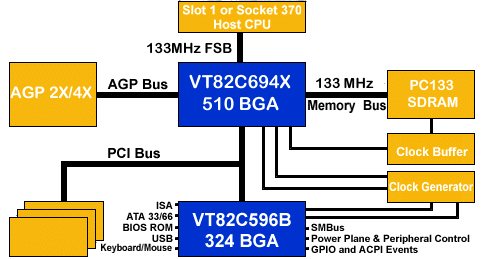VIA Apollo Pro 266: The P3 gets DDR
by Anand Lal Shimpi on January 18, 2001 2:36 AM EST- Posted in
- CPUs
The Apollo Pro 266
As opposed to the past few chipset releases from VIA, the Apollo Pro 266 is a significant departure from the Apollo Pro 133A If you remember, the KX133 and KT133 chipsets were actually not so distant relatives of the Apollo Pro 133A, they shared the same memory and AGP controllers and with VIA's flexible designs they used the same South Bridge controller as well. The only real difference between the Apollo Pro 133A North Bridge and that used on the KX133 and KT133 chipsets was that the latter interfaced with the Athlon's EV6 bus.
The one thing that has remained constant throughout every single VIA chipset release, even dating back to the days of the old Socket-7 chipsets is the fact that the PCI bus has always connected the North Bridge and South Bridge. That's right, the 32-bit, 33MHz Peripheral Component Interconnect bus is what has "bridged" the gap between the two major chips in all VIA chipsets. This was true of all Intel chipsets up to and including the i440BX before they moved to the Intel Hub Architecture.
The "old" way: PCI Bus connects North & South
Bridges

As a quick refresher, the North Bridge is what houses the memory and AGP controllers. It is also the chip that lies connects directly to the CPU, thus controlling your FSB frequency among other things related to your CPU bus interface.
The South Bridge handles any ISA bridges, the integrated hard drive controller, it contains the USB controller and in the case of VIA's 686A, it also houses the keyboard/mouse controllers.
In a conventional chipset such as the Apollo Pro 133A and the i440BX, the North Bridge is connected to the South Bridge via the PCI bus. As we mentioned before, this is a 32-bit connection that operates at 33MHz resulting in 133MB/s of available bandwidth. All of the PCI devices, as well as any traffic that occurs between the North and South bridges share this bandwidth.
With current IDE hard drives approaching 40MB/s sustained transfer rates, USB devices becoming increasingly more popular and 100Mbit Ethernet cards eating up this 133MB/s of available bandwidth there is a need to remove this potential bottleneck from the system.










0 Comments
View All Comments